Losing the American Dream
As a presidential election year approaches, pollsters are searching to measure the pulse of those who will be voting in 2024. A question is confounding analysts examining poll results, why is a U.S. economy that is exceeding expectations with low rates of unemployment; healthy job growth; decreasing rate of inflation; and increasing worker pay, not convincing voters that happy days are here again?
A widely shared consensus was expressed recently by former U.S. Secretary of Labor Robert Reich: “the vast number of working non-college grads – some two-thirds of the adult U.S. population – are still bogged down in dead-end jobs lacking any economic security.” So while the economy may be getting better overall, “the rich get richer, the poor grow poorer, and the working middle is under worsening siege.”
Anxiety over a future made uncertain by a pandemic, war, political polarization, recent years of high inflation, and climate change, as well as troubling social issues related to gender identity and abortion, causes even the relatively well off to have no confidence that even if life is relatively comfortable, it’s not going to last.
Not exactly the picture of the American Dream. David Leonhardt, columnist for the New York Times, has a new book titled Ours Was the Shining Future. His definition of the American Dream is Americans making more money than their parents had, “enjoying better material standards than one’s parents.” Many sources have suggested that a reversal is happening for the first time in the country’s history.
 Fifty Year Perspective has documented this reversal in numerous blog posts over the last seven years. A post during the pandemic in March 2022 documented that workers with more years of education were more likely to have occupations suitable for teleworking from home. (Click on image to enlarge.) Without the ability to work from home, workers were in and out of work as the pandemic went through a series of lockdowns.
Fifty Year Perspective has documented this reversal in numerous blog posts over the last seven years. A post during the pandemic in March 2022 documented that workers with more years of education were more likely to have occupations suitable for teleworking from home. (Click on image to enlarge.) Without the ability to work from home, workers were in and out of work as the pandemic went through a series of lockdowns.
Several economic trends changed direction in the 1970s. Hourly compensation flatlined in the mid-1970s while productivity continued to grow. From 1948 to 1975, worker pay increased by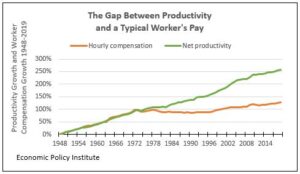 nearly 100% and productivity increased over 90%. By 2019 worker pay had barely increased beyond its 1975 level. But productivity had increased by almost 260% since 1948, double the rate of increase for workers’ pay. Productivity gains were not benefitting workers.
nearly 100% and productivity increased over 90%. By 2019 worker pay had barely increased beyond its 1975 level. But productivity had increased by almost 260% since 1948, double the rate of increase for workers’ pay. Productivity gains were not benefitting workers.
Prosperity raised living standards for a majority of the population in the U.S. immediately following World War II. The 1970s brought a reversal of the economic gains for middle and lower class families. The share of national income going to the top one percent of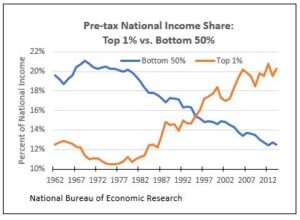 households increased dramatically while the bottom 50 percent declined. In 1969 the bottom 50% of households received 21.1% of income and the top 1% received 11.4%. By 2014 relative positions had switched: the bottom 50% received 12.5% of income and the top 1% received 20.3%.
households increased dramatically while the bottom 50 percent declined. In 1969 the bottom 50% of households received 21.1% of income and the top 1% received 11.4%. By 2014 relative positions had switched: the bottom 50% received 12.5% of income and the top 1% received 20.3%.
CEO pay has wildly outpaced worker pay. In 1965 CEO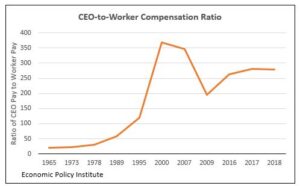 compensation was 19.9 times that of the average worker. The ratio of CEO pay to worker compensation increased exponentially. By 2018 that ratio had increased to 278 times worker pay. Dips occurred during the 2001 recession and the Great Recession of 2007.
compensation was 19.9 times that of the average worker. The ratio of CEO pay to worker compensation increased exponentially. By 2018 that ratio had increased to 278 times worker pay. Dips occurred during the 2001 recession and the Great Recession of 2007.
Union membership peaked in the U.S. in the 1950s at over 30% of wage and salary workers. By 2019 it had fallen to 10.8%, denying workers representation in contract negotiations. In August 1981, President Ronald Reagan set a precedent by firing 11,359 air traffic controllers, members of the PATCO union, who had gone on strike. Use of strikes as a negotiating tool declined after President’s Reagan’s intervention.
wage and salary workers. By 2019 it had fallen to 10.8%, denying workers representation in contract negotiations. In August 1981, President Ronald Reagan set a precedent by firing 11,359 air traffic controllers, members of the PATCO union, who had gone on strike. Use of strikes as a negotiating tool declined after President’s Reagan’s intervention.
The U.S. has a progressive income tax, which means that the highest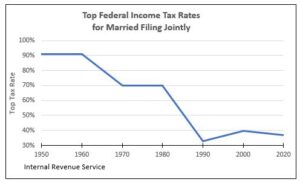 rate of taxation on income applies to the highest income earners. In 1950 the top rate of 91% applied to incomes above $4.9 million in today’s dollars. The 70% top rate in 1980 when President Reagan was elected applied to incomes over $765,000 in today’s dollars. Reagan ran on a commitment to lower income taxes. He oversaw the top income tax rate cut from 70% in 1982 to 50% in 1981, then to 38.5% in 1986, and 28% by the time he left office in 1989. Leonhardt notes that between the mid-1940s and mid-1970s “raises won by unions most often reduced profits without damaging the economy.”
rate of taxation on income applies to the highest income earners. In 1950 the top rate of 91% applied to incomes above $4.9 million in today’s dollars. The 70% top rate in 1980 when President Reagan was elected applied to incomes over $765,000 in today’s dollars. Reagan ran on a commitment to lower income taxes. He oversaw the top income tax rate cut from 70% in 1982 to 50% in 1981, then to 38.5% in 1986, and 28% by the time he left office in 1989. Leonhardt notes that between the mid-1940s and mid-1970s “raises won by unions most often reduced profits without damaging the economy.”
The American Dream is about intergenerational mobility – the ability to enjoy higher material standards than one’s parents. For the immediate post-war period that hope was realized for an increasing portion of the population. A study tracking economic mobility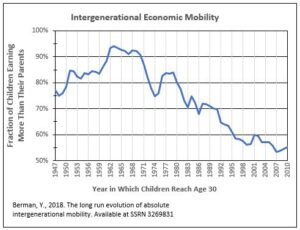 measured the percentage of 30-year-olds who were earning more than their parents at age 30. In 1947, 77% of 30-year-olds were earning more than their parents had. In 1963 that number had increased to 94.1%. Then between 1963 and 2010, the last year of the study, this measure of intergenerational inequality had decreased to 55.2%.
measured the percentage of 30-year-olds who were earning more than their parents at age 30. In 1947, 77% of 30-year-olds were earning more than their parents had. In 1963 that number had increased to 94.1%. Then between 1963 and 2010, the last year of the study, this measure of intergenerational inequality had decreased to 55.2%.
Lax antitrust enforcement shares responsibility for limiting economic mobility. A post in September 2018 documented impacts of trends in corporate concentration through mergers and acquisitions, antitrust enforcement, lobbying and competitiveness. Corporate concentration allows businesses to raise prices while keeping wages low. Under a lenient U.S. antitrust policy companies can dominate a whole industry and can thereby lower wages because workers have fewer alternative employers.
An earlier post in April 2023 discussed the Supreme Court’s January 21, 2010, opinion in Citizens United v. Federal Election Commission, (FEC). Election spending restrictions in place for over 100 years prior to Citizens United were overturned by the Supreme Court decision, which enabled “independent political spending,” provided it was not coordinated with a candidate’s campaign. A decision two months later, SpeechNow.org v, FEC, paved the way for super PACS to raise practically unlimited sums on political campaigns. As Leonhardt notes in his book, “Into the mid-1970s, only six hundred registered lobbyists worked in Washington. Today. more than twelve thousand do.”
Bleak as this picture is, there is hope in small steps toward rectifying the mistakes of the past fifty years. “Reviving the American Dream” is the next Fifty Year Perspective topic.
